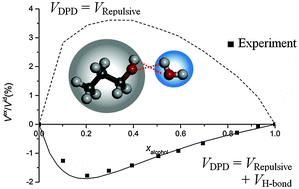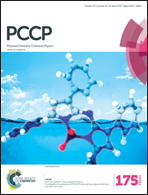Hydrogen bonding in DPD: application to low molecular weight alcohol–water mixtures†
Abstract
In this work we propose a computational approach to mimic hydrogen bonding in a widely used coarse-grained simulation method known as dissipative particle dynamics (DPD). The conventional DPD potential is modified by adding a Morse potential term to represent hydrogen bonding attraction. Morse potential parameters are calculated by a mapping of energetic and structural properties to those of atomistic scale simulations. By the addition of hydrogen bonding to DPD and with the proposed parameterization, the volumetric mixing behavior of low molecular weight alcohols and water is studied and experimentally observed negative volume excess is successfully predicted, contrary to the conventional DPD implementation. Moreover, the density-dependent DPD parameterization employed provides the asymmetrical shapes of the excess volume curves. In addition, alcohol surface enrichment at the air interface and self-assembly in the bulk is studied. The surface concentrations of alcohols at the air interface compare favorably with the experimental observations at all bulk-phase alcohol fractions and, in consonance with experiment, some clustering is observed.


 Please wait while we load your content...
Please wait while we load your content...